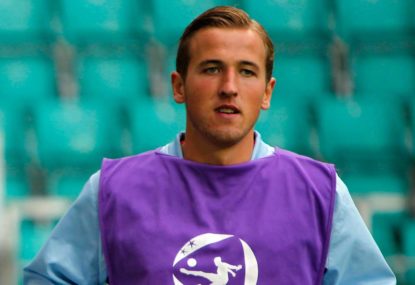Young excellence, promotion battles, and a happy farewell: The Australian team of the week from players around the globe
Even though St.Pauli ultimately lost a high-scoring affair, Jackson Irvine was a standout, as well as scoring a late goal.

The international debut of Harry Kane could hardly have gone any better, with the Spurs starlet netting within 80 seconds of taking the Wembley pitch against Lithuania.
Indeed, the UK tabloids were positively (and predictably) gushing over the young man who has quickly become the darling of English football, and it’s little wonder.
Kane has managed 29 goals for Spurs so far this season and has set the Premier League alight with some outstanding performances. From an Australian perspective then, it begs the question, can we produce a Harry Kane of our own?
Since the inception of the A-League, there has been a distinct lack of quality number nines produced. The first young player to fit the mould was Bruce Djite, who occasioned incredible hype at the time.
I remember reading an article by a well known football columnist (and former Roarer) labelling Djite “the next Mark Viduka”. High praise indeed, though completely unfair and unwarranted.
To put this in perspective, during his first two seasons in the NSL, Viduka scored 40 goals in 48 games – while Djite managed 13 from 41. Not a bad return to be sure, but a long way short of the mark.
Over the following years, we’ve seen other youngsters show promise; Nikita Rukavytsya (who was converted into more of a wide attacker during his European sojourn), Eli Babalj, and more recently Adam Taggart and Tomi Juric. Taggart has, without doubt, come the closest to emulating Kane. He scored 16 times in his final year at the Jets, though injury has so far stifled his chances of continuing that form since moving to Fulham.
Even if Taggart kicks on and fulfils his promise, one number nine in 10 years is still a pretty poor return. But why is this the case? Obviously the more attacking positions require greater technique.
We all know about the technical deficiencies in Australian players and how the FFA is slowly addressing the issue, so I won’t discuss that here – even though it is a critical element. Instead, I would prefer to focus discussion on another area that the Kane story has uncovered, and it is as relevant in Australia as it is in England.
FA chairman Greg Dyke recently went on record to address the lack of young English players getting opportunities in the Premier League, posing the question “How many more Harry Kanes are out there, who just can’t get a game?”. It is a poignant question, with implications that apply here too.
The priority of A-League clubs is to be successful and win trophies, not to produce players for the national team. It’s little wonder then that visa slots are usually filled with attack-minded players. The obvious down side of this is that it significantly limits opportunities for young attackers of our own.
It’s a complex issue with no easy answers, but one that must be addressed at some point. Perhaps there can be some kind of incentive for clubs, financial or otherwise, for leaving visa spots empty?
It was blindingly obvious against Germany that, while we played superbly, we still lacked that potent, cutting edge up front. I can only imagine what a Harry Kane of our own would do for us, not just in terms of results, but the unbridled joy strikers bring when they are banging them in.